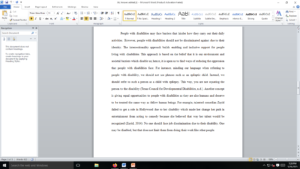Disability and disability rights
In this week’s materials, we’re exploring key concepts associated with disability and disability rights. Something you may have noticed as we have examined different kinds of diversity in this course is that in all these categories, there is an assumption about which state is “normal.” Last week, we saw that many white people don’t necessarily see themselves as having a race, because white is the “normal” category. Because of this, the experiences of Black, Latinx, Asian, Native American, and other non-white people can be invisible. In a similar way, our culture views non-disabled people as normal and may make the experiences of disabled people invisible. I encourage you to consider this idea as you work through the material this week.
Using at least 2 of the required resources this week, and 350 words or more not including learning resources please answer the following questions:
- In one of the week’s readings, Davis (2015) argues that disability is often left out of discussions of diversity, equity, and inclusion (DEI). Why do you think this might be?
- What does the term “TAB” (temporarily able-bodied) mean in the context of disability studies? What does this term add to your understanding of disability?
- How might the concepts of intersectionality and privilege relate to the experiences of people with disabilities? Please give at least two examples.
BEHS 220 Week 7 Required Resources
Adams, R., Reiss, B., & Serlin, D. (2015). Disability. In Keywords for Disability Studies, edited by R. Adams, B. Reiss, & D. Serlin. Pp. 5-11. http://ezproxy.umgc.edu/login?
Davis, L.J. (2015). Chapter 19: Diversity. In Keywords for Disability Studies, edited by R. Adams, B. Reiss, & D. Serlin. Pp. 61-64. http://ezproxy.umgc.edu/login?
Ridgway, S. (2013, March 5). 19 Examples of Ability Privilege. Everyday Feminism. https://everydayfeminism.com/
Texas Council for Developmental Disabilities. (n.d.). People First Language. https://tcdd.texas.gov/
Zayid, M. (2014, January). I got 99 problems … palsy is just one [Video]. TED Conferences. https://www.ted.com/talks/
Answer preview
. However, people with disabilities should not be discriminated against due to their identity. The intersectionality approach builds enabling and inclusive support for people living with disabilities. This approach is based on the belief that it is our environment and societal barriers which disable us; hence, it is upon us to find ways of reducing the oppression that people with disabilities face. For instance, minding our language when referring to people with disability, we should not use phrases such as an epileptic child. Instead, we should refer to such a person as a child with epilepsy. This way, you are not equating the person to the disability (Texas Council for Developmental Disabilities, n.d.). Another concept is giving equal opportunities to people with disabilities as they are also humans and deserve to be treated the same way as fellow human beings. For example, talented comedian Zayid failed to get a role in Hollywood due to her disability which made her change her path in entertainment from acting to comedy because she believed that way her talent would be recognized (Zayid, 2014). No one should face job discrimination due to their disability. One may be disabled, but that does not limit them from doing their work like other people.
[622 Words]

Disability and disability rights

